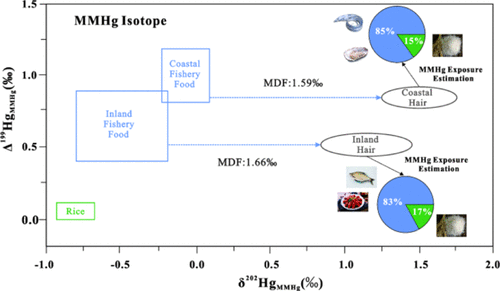当前位置:
X-MOL 学术
›
Environ. Sci. Technol.
›
论文详情
Our official English website, www.x-mol.net, welcomes your feedback! (Note: you will need to create a separate account there.)
Compound-Specific Stable Isotope Analysis Provides New Insights for Tracking Human Monomethylmercury Exposure Sources
Environmental Science & Technology ( IF 11.4 ) Pub Date : 2021-09-01 , DOI: 10.1021/acs.est.1c01771 Shaochen Yang 1 , Bo Wang 2 , Chongyang Qin 2 , Runsheng Yin 3 , Ping Li 2, 4 , Jinling Liu 1 , David Point 5 , Laurence Maurice 5 , Jeroen E Sonke 5 , Leiming Zhang 6 , Xinbin Feng 2, 4
Environmental Science & Technology ( IF 11.4 ) Pub Date : 2021-09-01 , DOI: 10.1021/acs.est.1c01771 Shaochen Yang 1 , Bo Wang 2 , Chongyang Qin 2 , Runsheng Yin 3 , Ping Li 2, 4 , Jinling Liu 1 , David Point 5 , Laurence Maurice 5 , Jeroen E Sonke 5 , Leiming Zhang 6 , Xinbin Feng 2, 4
Affiliation

|
Monomethylmercury (MMHg) exposure can induce adverse neurodevelopmental effects in humans and is a global environmental health concern. Human exposure to MMHg occurs predominately through the consumption of fishery foods and rice in Asia, but it is challenging to quantify these two exposure sources. Here, we innovatively utilized MMHg compound-specific stable isotope analyses (MMHg-CSIA) of the hair to quantify the human MMHg sources in coastal and inland areas, where fishery foods and rice are routinely consumed. Our data showed that the fishery foods and rice end members had distinct Δ199HgMMHg values in both coastal and inland areas. The Δ199HgMMHg values of the human hair were comparable to those of fishery foods but not those of rice. Positive shifts in the δ202HgMMHg values of the hair from diet were observed in the study areas. Additionally, significant differences in δ202Hg versus Δ199Hg were detected between MMHg and inorganic Hg (IHg) in the human hair but not in fishery foods and rice. A binary mixing model was developed to estimate the human MMHg exposures from fishery foods and rice using Δ199HgMMHg data. The model results suggested that human MMHg exposures were dominated (>80%) by fishery food consumption and were less affected by rice consumption in both the coastal and inland areas. This study demonstrated that the MMHg-CSIA method can provide unique information for tracking human MMHg exposure sources by excluding the deviations from dietary surveys, individual MMHg absorption/demethylation efficiencies, and the confounding effects of IHg.
中文翻译:

特定化合物的稳定同位素分析为追踪人类单甲基汞暴露源提供了新的见解
单甲基汞 (MMHg) 暴露会对人类神经发育产生不利影响,并且是一个全球性的环境健康问题。在亚洲,人类对 MMHg 的暴露主要是通过食用渔业食品和大米,但量化这两种暴露来源具有挑战性。在这里,我们创新地利用头发的 MMHg 化合物特异性稳定同位素分析 (MMHg-CSIA) 来量化沿海和内陆地区的人类 MMHg 来源,这些地区经常食用渔业食品和大米。我们的数据显示,在沿海和内陆地区,渔业食品和稻米末端成员具有不同的 Δ 199 Hg MMHg值。Δ 199 Hg MMHg人类头发的价值可与渔业食品相媲美,但与大米相比则不然。在研究区域观察到饮食中头发的 δ 202 Hg MMHg值发生正变化。此外,在人类头发中的 MMHg 和无机 Hg (IHg) 之间检测到δ 202 Hg 与 Δ 199 Hg 的显着差异,但在渔业食品和大米中未检测到。开发了一个二元混合模型,以使用 Δ 199 Hg MMHg估计人类从渔业食品和大米中的 MMHg 暴露量数据。模型结果表明,在沿海和内陆地区,人类 MMHg 暴露主要 (>80%) 受渔业食品消费的影响,而受大米消费的影响较小。这项研究表明,MMHg-CSIA 方法可以通过排除饮食调查的偏差、个体 MMHg 吸收/去甲基化效率以及 IHg 的混杂效应,为追踪人类 MMHg 暴露源提供独特的信息。
更新日期:2021-09-21
中文翻译:

特定化合物的稳定同位素分析为追踪人类单甲基汞暴露源提供了新的见解
单甲基汞 (MMHg) 暴露会对人类神经发育产生不利影响,并且是一个全球性的环境健康问题。在亚洲,人类对 MMHg 的暴露主要是通过食用渔业食品和大米,但量化这两种暴露来源具有挑战性。在这里,我们创新地利用头发的 MMHg 化合物特异性稳定同位素分析 (MMHg-CSIA) 来量化沿海和内陆地区的人类 MMHg 来源,这些地区经常食用渔业食品和大米。我们的数据显示,在沿海和内陆地区,渔业食品和稻米末端成员具有不同的 Δ 199 Hg MMHg值。Δ 199 Hg MMHg人类头发的价值可与渔业食品相媲美,但与大米相比则不然。在研究区域观察到饮食中头发的 δ 202 Hg MMHg值发生正变化。此外,在人类头发中的 MMHg 和无机 Hg (IHg) 之间检测到δ 202 Hg 与 Δ 199 Hg 的显着差异,但在渔业食品和大米中未检测到。开发了一个二元混合模型,以使用 Δ 199 Hg MMHg估计人类从渔业食品和大米中的 MMHg 暴露量数据。模型结果表明,在沿海和内陆地区,人类 MMHg 暴露主要 (>80%) 受渔业食品消费的影响,而受大米消费的影响较小。这项研究表明,MMHg-CSIA 方法可以通过排除饮食调查的偏差、个体 MMHg 吸收/去甲基化效率以及 IHg 的混杂效应,为追踪人类 MMHg 暴露源提供独特的信息。



























 京公网安备 11010802027423号
京公网安备 11010802027423号